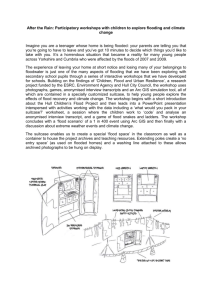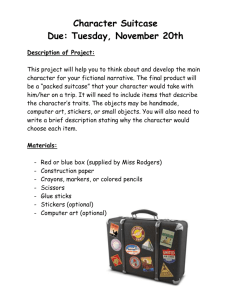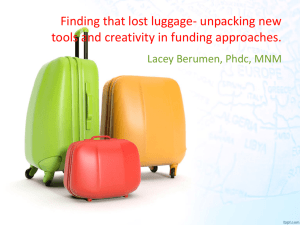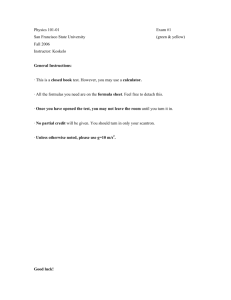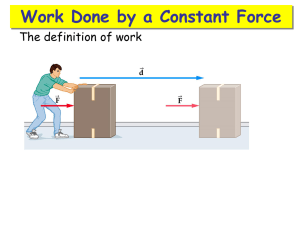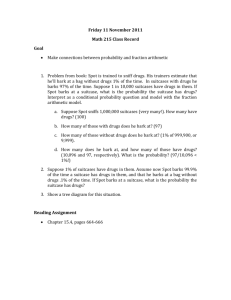Document 11182558
advertisement
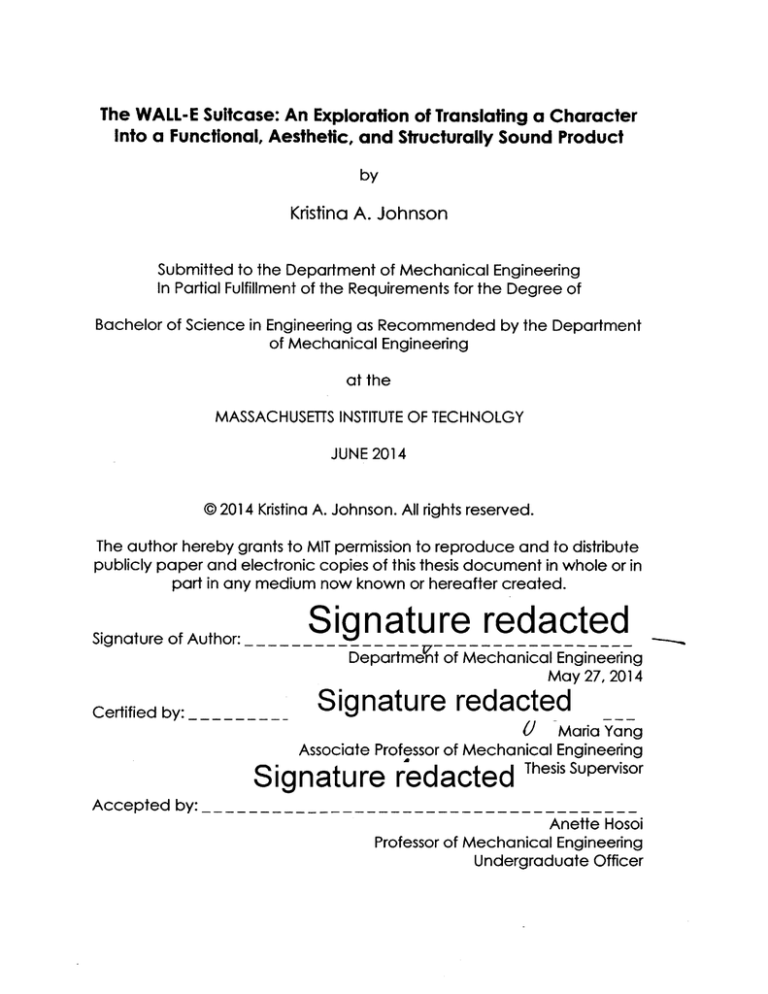
The WALL-E Suitcase: An Exploration of Translating a Character Into a Functional, Aesthetic, and Structurally Sound Product by Kristina A. Johnson Submitted to the Department of Mechanical Engineering In Partial Fulfillment of the Requirements for the Degree of Bachelor of Science in Engineering as Recommended by the Department of Mechanical Engineering at the MASSACHUSETTS INSTITUTE OF TECHNOLGY JUNE 2014 2014 Kristina A. Johnson. All rights reserved. The author hereby grants to MIT permission to reproduce and to distribute publicly paper and electronic copies of this thesis document in whole or in part in any medium now known or hereafter created. redacted Signature ------------------- Signature of Author: Department of Mechanical Engineering May 27, 2014 Certified by:---------- Signature redacted 0 -Maria Yang Associate Professor of Mechanical Engineering Signature redacted Accepted by: ThesisSupervisor ____________________ Anette Hosoi Professor of Mechanical Engineering Undergraduate Officer The WALL-E Suitcase: An Exploration of Translating a Character Into a Functional, Aesthetic, and Structurally Sound Product by Kristina A. Johnson Submitted to the Department of Mechanical Engineering on May 27, 2014, in Partial Fulfillment of the Requirements for the Degree of Bachelor of Science in Engineering as Recommended by the Department of Mechanical Engineering Abstract This thesis presents a product design case study that effectively translates a well-known character into a well-loved product. Character merchandising is not often a topic discussed in design curriculum, though it is a popular strategy for marketing and selling consumer products. This case study documents the design and development of a product, including its features and the process of design and fabrication. This thesis will also document the evaluation of the suitcase as a product, both functionally and aesthetically. Thesis Supervisor: Maria Yang Title: Assistant Professor of Mechanical Engineering 2 Acknowledgements First and foremost I would like to thank my Lord and Savior, Jesus Christ. Without Him, none of this would have been possible. To Him be all the glory. Philippians 4:13 - I can do all things through Him who gives me strength. Thank you to my advisor, Maria Yang. First, for accepting to be my advisor even with a project as unique and ambitious as the one I chose and second, for sticking with me throughout the process and answering all of my questions and giving me advice along the way. Thank you to Professor Wallace who spent so many hours helping me to build thermoform molds and helping me to become proficient in using the thermoformer so I could continue doing it on my own. Thank you also for all of the advice on how to make the wheel axle - it works like a charm! Thank you to the Pappalardo Staff - Bill Cormier, Tasker Smith, Steve Haberek, and Jim Dudley. Thank you to Bill and Tasker who gave me so much of their time in my final week of construction and for all of the knowledge of machining that they gave me. Thank you to Steve for always joking around with me; even if I come into lab feeling miserable, I leave with a smile on my face. And thank you to Jim for being supportive of my work even after all those times I've made you want to pull your hair out. Thank you to the 4.500 staff - Brandon Clifford, Sixto Cordero, and Austin Smith. Thank you for being my encouragement when my project was just an idea and for giving me the guidance I needed to accomplish the first prototype. 3 Table of Contents 1. Introduction........................................................................ Page 9 1.1 Initial Concept............................................................... Page 9 1.2 Motivation..................................................................... Page 10 1.3 Related Products........................................................... Page 11 2. The Design.......................................................................... Page 14 2.1 College Students Niche.................................................. Page 14 2 .2 Size ................................................................................ Pa g e 14 2.3 Materials....................................................................... Page 15 2.4 Eyes.............................................................................. Page 15 2.5 Product Contract.......................................................... Page 16 3. Initial Prototype..................................................................... Page 17 3.1 Constructing the Body.................................................... Page 17 3.2 Constructing the Feet...................................................... Page 19 3.3 Constructing the Extremities............................................ Page 20 3.4 Finishing Touches...................................................................... Page 24 3.5 Lessons Learned from First Prototype..................................... Page 25 4. The Design/Build Process of the Current Model........................ Page 27 4.1 Thermoforming the Body............................................... Page 27 4.2 Assembly of the Body.................................................... Page 30 4.3 Eye and Arm Pieces...................................................... Page 32 4.4 Laptop Sleeve............................................................... Page 35 4 4.5 Finishing Touches........................................................... Page 37 4.5.1 Fabric Lining............................................................. Page 37 4.5.2 Zipper and Hinge....................................................... Page 38 4.5.3 Wheels...................................................................... Page 40 4.5.4 Handle...................................................................... Page 42 5. Results and Future Considerations......................................... Page 43 5.1 Checked Luggage........................................................ Page 44 5.2 Igloo Cooler................................................................... Page 45 5.3 Paint................................................................................ Page 46 5.4 Lessons Learned from the Second Prototype ........... Page 48 5 List of Figures Figure 1 -1: An R2-D2 themed suitcase......................................... Page Figure 1-2: A WALL-E themed backpack..................................... Page Figure 3-1: An initial CAD model of the suitcase........................ Page Figure 3-2: Machining slots into the thermoform mold.............. Page Figure 3-3: Setting-up the body mold in the thermoformer....... Page Figure 3-4: The process of constructing the "feet" of WALL-E... Page Figure 3-5: Geometries of the eye and arm pieces................... Page Figure 3-6: Constructing the eyes using CAD geometries......... Page Figure 3-7: The completed wooden eye mold........................... Page Figure 3-8: The completed wooden arm mold........................... Page Figure 3-9: The Rub-R-Mold of the arm........................................ Page Figure 3-10: Using the Rub-R-Mold to cast the arm...................... Page Figure 3-11: The casted arms after being painted....................... Page Figure 3-12: The completed suitcase body................................... Page Figure 4-1: Solidworks model of the suitcase panels.................. Page Figure 4-2: Positive thermoform mold of the front panel........... Page Figure 4-3: Positive thermoform mold of the bottom panel...... Page Figure 4-4: Thermoforming the front panel of the suitcase....... Page Figure 4-5: Fitting the panels together to find collisions............. Page Figure 4-6: Bottom and side panels riveted together................ Page 6 Figure 4-7: Laser cutting eye and arm templates...................... Page 33 Figure 4-8: WALL-E's eyes as a storage compartment............... Page 34 Figure 4-9: The locking mechanism of WALL-E's eyes................ Page 35 Figure 4-10: Cutting out fabric for the laptop sleeve................... Page 36 Figure 4-11: The zipper on the finished laptop sleeve.................. Page 37 Figure 4-12: The lining of the suitcase............................................. Page 38 Figure 4-13: The zipper of the suitcase........................................... Page 39 Figure 4-14: The hinge of the opening of the suitcase................. Page 40 Figure 4-15: Constructing the wheel axle...................................... Page 41 Figure 4-16: The wheel axle attached to the suitcase................. Page 41 Figure 4-17: The suitcase handle.................................................... Page 42 Figure 5-1: The finished suitcase with the handle retracted...... Page 43 Figure 5-2: The finished suitcase with the handle extended..... Page 44 Figure 5-3: WALL-E with a cooler................................................... Page 45 Figure 5-4: The first layer of paint on the eyes............................. Page 46 Figure 5-5: The second layer of paint on the eyes..................... Page 47 7 List of Tables Table 2-1: An outline of the design requirements...................... Page 16 8 Chapter 1 Introduction Character-based licensing is a popular strategy for marketing and selling consumer products to a broad audience. It can be readily seen in children's products - everything from toys to clothing to dishware - and can also be seen in adult products, like coffee mugs or calendars. However, the adoption of character-based themes in products is rarely explored in the engineering or product design classes. This thesis explores the following question: "How can the designer take a character and effectively and imaginatively adapt to a particular product?" 1.1 Initial Concept Character merchandising is a topic that I have been interested in for a while, but up until my senior year, I had not found an opportunity to explore it. In the fall of 2013, I took a class called Intro to Design Computing in the architecture department (4.500). The project for our final was called "Pro-toy-type"; the basic premise was to make an object that had apparent forms of interaction. Other than that, the assignment was open ended. In the projects leading up to the final, I had been experimenting with integrating characters into the design of my 9 assignment submissions. This time, I wanted to incorporate the character WALL-E. Once I had settled on incorporating WALL-E into my project, I had to figure out how exactly to build it so that it was interactive. The first thought that came to mind was a trash bin - the initial intended purpose of the WALL-E robots were trash collectors. It seemed fitting, but it was also unoriginal and did not have much interaction. The basic interactions we have with trashcans are putting something in them, replacing the bag, and avoiding them. After thinking through the use case, I decided that making the WALL-E into a trashcan would not be the correct way to go. I kept brainstorming, but the only other objects that came to mind were boxes and paper trays. Suddenly, the thought of making a WALL-E - suitcase formed. It was perfect: suitcases naturally require interactivity we use suitcases to transport belongings and throughout the time of transporting, the suitcase is constantly being touched - as well as the fact the suitcases already have a form factor very similar to WALL-E. 1.2 Motivation - The motivation for moving forward with the initial idea is two fold novelty and immersive experience. In making a WALL-E suitcase, I hope to provide users with a chance to meet a favorite character in real life - to 10 have a chance to touch and interact with it. By providing the user with a WALL-E suitcase, I am giving the user an opportunity to own a suitcase that is visually intriguing and tangibly stimulating. 1.3 Related Products To start the design of my suitcase, I brainstormed related products to see what products other companies have made. There were two products in particular that I found helpful in thinking about the design of my suitcase. The first product that I found helpful was an R2-D2 themed suitcase, which can be seen in Figure 1-1. This product is designed so that it keeps the structure of a regular suitcase, but the shell is decorated to look like R2-D2. While this is not the direction I wanted to go in building my WALL-E suitcase, it helped me start thinking about what I did want to include in the construction. After seeing this suitcase, I started brainstorming how I could make a suitcase that had actual arms, real lights, and surface details - all aspects that would better imitate the real character than just a simple decal. 11 Figure 1-1: An R2-D2 themed suitcase.1 The second product I was inspired by was a WALL-E backpack. While not a suitcase, this backpack had a form factor similar to what I wanted to do with the suitcase. The eyes and arms are visibly separate from the main body piece and there are different compartments for storage. 1 Source: http://www.geekalerts.com/u/R2-D2-suitcase.jpg 12 Figure 1-2: A WALL-E themed backpack.2 2Source: http://ecx.images-amazon.com/images/I/51U80ZYgK8L._SY300.jpg 13 Chapter 2 Design 2.1 College Students Niche One of the apparent challenges in designing this suitcase was deciding the target market. At first I considered having children be the potential market, but then I realized that certain functionality that I desired to add in the suitcase - such as a laptop sleeve - would be unnecessary for children. This is when I decided on targeting college students and young adults with my product. By targeting this market, I could combine the aesthetics and the functionality I wanted to create a fun, but highly usable product. 2.2 Size This suitcase is built to be a carry-on bag, and airlines have restrictions on the dimensions of carry-on luggage. For most airlines, 14" wide by 22" long by 9" deep are the maximum dimensions. This was something I had to take into consideration while designing the suitcase. 14 2.3 Materials Suitcases have long been made out of soft materials such as leather and cloth. It has been the trend in recent years, however, that companies have started selling hard shell suitcases. In making a WALL-E suitcase, it is only fitting to construct it using the hard shell technique. This is for three reasons. First, it more aptly matches the visual aesthetics of WALLE being a robot. Second, making the body out of plastic makes it easy to create features such as the arms and surface details on the main body such as rivets and milled lines. Third, plastic is easier to paint than a soft material such as fabric, so it is easier to achieve the desired colors. 2.4 Eyes One of the most defining attributes of WALL-E are his eyes. They are what give him expression and, hence, allow the viewer to feel empathetic towards him. However, because of the size restrictions that I mentioned in section 2.2, adding the eyes as a feature takes away space from the main body compartment. To help address this, I decided to make the eyes carrying compartments themselves. While this does not completely make up for the lost space, it does give the user a convenient place to store pens, gum, IDs, and other necessary objects for travel. 15 2.5 Product Contract The design requirements that I took into consideration while building the suitcase are shown in Table 1. Table 1: An outline of the design requirements for the suitcase. Protective and Easily Accessible Laptop Storage Laptop Sleeve Sleeve foam-padded on both sides, placed inside the front panel of the suitcase Easily manuaverable Transportability Smooth spinning 16 Chapter 3 Initial Prototype 3.1 Constructing the Body As mentioned earlier, the initial prototype was created in a class called Introduction to Design Computing. Figure 3-1 shows the initial CAD model, as modelled in Rhino 3D. Figure 3-1: The initial CAD model of the suitcase. 17 To make the body, I used Medium Density Fibreboard (MDF) to create a positive mold. I created a mold that had a 5* draft angle. I also used a CNC Mill to machine slots into the front face of the body. These three vertical indents can be seen on WALL-E in the movie. Figure 3-2: Machining slots into the thermoform mold for the body. To thermoform, I used the vacuum thermoformer in Pappalardo, as can be seen in Figure 3-3. I used 1/8" clear acrylic for the thermoforming. 18 Figure 3-3: Setting-up the body mold in the thermoformer 3.2 Constructing the Feet I constructed the treads, or the "feet" of WALL-E, by hand. I first started with the basic shape of the treads with the space left open for the wheel. I then copied this shape a number of times and removed extra material as I needed. To do this, I first made the top layer - the one with al of the detailing. I then drilled out the vacuum air holes, which gave me guidance for how much of the internal structure to take away. After taking away a portion of the internal material, the vacuum holes could be seen even when looking from the underside of the pieces. This process can be seen in Figure 3-4. After constructing the feet, I drilled a hole for 19 the shaft for the wheels. I then painted it, making sure to add some brown for the dirt that WALL-E tends to track everywhere. Figure 3-4: The process of constructing the "feet" of WALL-E. 3.3 Constructing the Extremities To make the eye and arm pieces, I used a command in Rhino called "UnrollSrf" to make the geometries that I needed flat on the xy plane, as shown in Figure 3-5. I then printed them out and glued them to the wood that I was using. With these templates, I cut out the shapes I needed to make the head and arm, as shown in Figure 3-6. 20 Figure 3-5: The geometries needed to construct the eye and arm pieces. Figure 3-6: Using the flattened geometries of the CAD model to construct the eyes. The complete wooden molds of the eyes and arm can be seen in Figures 3-7 and 3-8. 21 Figure 3-7: The completed wooden eye mold. Figure 3-8: The completed wooden arm mold. After making the positive wooden molds, I began the process of making the negative molds. To cast the head and the arms, I chose to use 22 Rub-R-Mold to create a latex shell that I would then cast in to. Because this was fairly flimsy, I covered the outside in plaster. The layers of both Rub-R-Mold and plaster can be seen in Figure 3-9. Figure 3-9: The Rub-R-Mold of the arm. The molds were then used to cast the eyes and arms. This process is shown in Figure 3-10. Figure 3-10: Casting an arm using the Rub-R-Mold 23 3.4 Finishing Touches After the eyes and arms had been casted and hardened, I painted them. Figure 3-11 shows the painted arms. I also painted the body, which proved to be challenging. Because I was painting from the inside instead of painting something on the outside, I had to paint the details first (like the name and the solar charge level) and do the background colors last. After painting the body, I attached the feet using hot glue and screws. The final body is shown in Figure 3-12. Figure 3-11: The casted arms after being painted. 24 Figure 3-12: The completed body of the suitcase. 3.5 Lessons Learned from First Prototype There are two primary things I learned during the first iteration. The first lesson I learned is the importance of maximizing space in the suitcase. Because checked bags now carry an inherent fee for most airlines, it is common practice to use a carry on bag to carry clothes, toiletries, and other items needed for the trip. In this prototype, because I focused on 25 getting the treads to look like treads, I sacrificed some of the user's storage space. The second lesson that I learned is that a suitcase should not be made out of one thermoformed piece of acrylic. Because it was just one thermoformed piece, the pull was 9" deep. This causes the plastic to be very thin on the edges. The suitcase ended up fracturing in a number of places because of this. This is how I cam to my decision to make the second iteration of the suitcase out of multiple panels of thermoformed parts. 26 Chapter 4 The Design/Build Process of the Current Model 4.1 Thermoforming the Body As mentioned in Section 3.4, for this second iteration, I decided to make the suitcase out of six panels, each their own separate thermoformed piece. To design the body, I used Solidworks. The final model can be seen in Figure 4-1. Solidworks helped me to conceptualize and finalize the dimensions of the suitcase. It also helped me to finalize the dimensions of the panels and how they fit together. FIGURE 4-1: Solidworks model of the suitcase panels 27 After designing the panels, I began constructing the thermoform molds for them. Two of the molds I made with MDF and two of the molds I made with high density polyurethane foam. Two molds, each of a different material, can be seen in Figures 4-2 and 4-3. Figure 4-2: Thermoform mold for the front panel made from high density foam. 28 Figure 4-3: Thermoform mold for the bottom panel made from MDF. After all of the molds had been made, I began thermoforming the panels using Kydex. After the front and back panels had been thermoformed, I had to use ABS for the remaining pieces because Altec Plastics, nor any other plastic manufacturers in the area, had Kydex in stock. Figure 4-4 shows the front panel being thermoformed. 29 Figure 4-4: Thermoforming the front panel of the suitcase. 4.2 Assembly of the Body After all of the panels had been thermoformed, I began assembling the body. First, I had to trim off excess plastic and sand the edges so that they were smooth and straight. Next, I fit the panels together to see where there were any collisions, as shown in Figure 4-5. I then trimmed some of the pieces to resolve these conflicts. 30 Figure 4-5: Fitting the panels together to find collisions. After trimming the panels appropriately, I riveted together the edges. Figure 4-6 shows the back panel (facing upwards) riveted to a side panel. The only panel I did not rivet was the front panel. This is because I will be attaching this panel to the main body via a hinge and zipper, as will be covered in Section 4.5.2. 31 Figure 4-6: The bottom panel (facing upwards) riveted to a side panel. 4.3 Eye and Arm Pieces For the second iteration of this suitcase, I tried different methods of construction for both the eyes and the arm pieces. For the arm pieces, I constructed them strictly out of high density foam and then painted them. To do this, I first took the Rhino 3D model from the previous iteration, as seen in Figure 3-5, and scaled the objects by a factor of 1.3. This made them appropriately sized for the second iteration. I then used a laser 32 cutter, as seen in Figure 4-7, to cut out templates to aid in constructing the arms out of the foam. Figure 4-7: Using the laser cutter to make eye and arm templates. To make the eyes, I created a two-part thermoform that I joined together. To make the molds, I used the templates laser cut on the same sheet as the arm pieces, seen in Figure 4-7. Once I had thermoformed the pieces, I built the mechanism for opening and closing the eyes. As shown in Figure 4-8, I built the eyes so that they open using a rivet as a pivot and 33 they stay in place with two additional rivets that fit snugly into holes in the plastic part of the eyes, as shown in Figure 4-9 Figure 4-8: WALL-E's eyes can open and close to reveal a storage compartment. 34 Figure 4-9: Rivets and appropriately sized holes are used to keep WALL-E's eyes shut. To bond the two eye halves, I used a solvent for joining acrylic. Once bonded, I trimmed the leftover plastic. I then made a small piece of green foam to use as the neck piece to attach the eyes to the body. 4.4 Laptop Sleeve The middle section on the front panel of the suitcase is the perfect size the fit a 15" laptop. This gave me the basis to construct the laptop sleeve. To make the sleeve, I first cut two pieces of foam in a 13"xl 0" rectangle each, as seen in Figure 4-10. I then sewed a fabric case for 35 each of the pieces of foam. Next, I sewed those pieces together to create the body and added a zipper so that the sleeve could close, as shown in Figure 4-11. Finally, I added large strips of Velcro to the back of the sleeve and to the inside of the suitcase so the sleeve can be detached when needed. Figure 4-10: Cutting out fabric to be used in sewing the laptop sleeve. 36 Figure 4-11: The laptop sleeve with a zipper 4.5 Finishing Touches 4.5.1 Fabric Lining The majority of suitcases are lined with fabric of some sort. This both protects the suitcase and protects the contents inside of the suitcase. It also adds a more professional feel to the product. To construct the inner lining, I cut pieces of fabric that were the size of each of the panels, plus " seam allowance. Next, I sewed the bottom and side panels together to create the main internal lining. This piece was then attached using rivets. To relieve some of the stress on the fabric, which may eventually cause the fabric to tear, I added a washer between the fabric and the 37 rivet head. This way, the fabric is "sandwiched" and the stress on the fabric is lessened. Figure 4-12 shows the inside of the suitcase. Figure 4-12: The lining of the suitcase. 4.5.2 Zipper and Hinge Similar to piecing together the body of the suitcase, I used rivets to affix the zippers and hinge to the body. Similar to the fabric lining, washers were used to sandwich the fabric to the body in order to prevent excess wear on the fabric of the zipper. The zipper is functionally two zippers that 38 cover half of the length of the body, one on each side, and meet in the middle. The hinge is located on the bottom panel and connects the front panel with the rest of the body. Figures 4-13 and 4-14 show the zipper and the hinge, respectively. Figure 4-13: The zipper of the suitcase. 39 Figure 4-14: The hinge that connects the front panel to the main body. 4.5.3 Wheels The wheels purchased are two rollerblade wheels with built-in bearings that have a 6mm through hole. To attach the wheels to the suitcase, I first made an axle. I did this by taking 1/2" aluminium stock, cutting it to a length of 11.5", and turning a hole in each end for the wheel pins. I then used an arbor press to insert the pins into the holes, as shown in Figure 4-15. The axle was then attached using custom-bent pieces of aluminium and rivets, as shown in Figure 4-16. 40 Figure 4-15: Using the arbor press to insert the pins into the axle. Figure 4-16: The axle attached to the body of the suitcase 41 4.5.4 Handle In designing the panels, I designed the back panel to have an indentation the same dimensions of the handle so it could be easily attached, as shown in Figure 4-17. In attaching the handle, I used bolts and lock nuts. Figure 4-17: The back panel was designed to fit the purchased handle. 42 Chapter 5 Results and Future Considerations Figure 5-1: The finished WALL-E Suitcase with the handle retracted. 43 Figure 5-2: The finished WALL-E Suitcase with the handle extended. 5.1 Checked Luggage In future iterations, I would consider making a larger version for checked luggage. While there are less exact restrictions for the size of checked baggage, one consideration is that it would need to be under 44 62 inches, otherwise fees would apply.3 Another consideration is that checked bags are handled more roughly than carry on luggage, so the suitcase would be made out of thicker plastic to accommodate this. 5.2 Igloo Cooler In the movie, WALL-e collects items he finds interesting when he goes out to compact trash. He keeps these items in a red cooler that he has attached to his back, as shown in Figure 5-3. In future iterations of this product, it would be fun to add a flip handle so that users could also carry a cooler on the suitcase. Figure 5-3: WALL-E and his cooler 3 http://www.aa.com/i18n/travellnformation/baggage/baggageAllowance.jsp#!oversize- weight 45 5.3 Paint To paint the eyes, I used two different layers of spray paint. The first layer was a reddish-brown color and the second layer was a metallic silver paint, both shown in Figures 5-4 and 5-5 respectively. Figure 5-4: The first layer of paint on the eyes - a reddish brown color. 46 Figure 5-5: The second layer of paint on the eyes - a metallic silver color. This method worked very well for the eyes. Because of the patchy layer of metallic paint over the reddish-brown color, I created a slightly rusted metallic look. Using the same process of color mixing, however, did not work for the body. I could not find the pale orange-yellow color of WALL-E's body in spray paint, so I tried blending various colors - yellow, orange, and white - to achieve WALL-E's body color. I did this on scrap pieces of plastic. The results were not consistent and each time I would end up with a different color or texture of paint. None of the attempts created a successful WALL-E body color. 47 Moving forward, research needs to be done on how to appropriately color plastic when non-standard colors are being used. Another possibility for coloring the suitcase could be by using decals. Both of these processes would need to be explored before a decision could be made. 5.4 Lessons Learned from the Second Prototype There were two main lessons I learned from this prototype. The first lesson I learned is in regards to the visual aspect of translating a character into a physical product. Making a three dimensional object of something that people have only seen in two dimensions is a more challenging endeavour than I had originally thought. One very important lesson I learned is that some details may need to diverge from the original character in order to look realistic. A good example of this is WALL-E's arms. Even though I designed them to be proportional to things like the eyes and body, they look bulky when attached. This may be because our eyes aren't trained to see items attached to the sides of suitcases or it may be for another reason entirely. Either way, relative sizing is something that needs to be considered when translating a two dimensional character into a three dimensional product. 48 The second lesson I learned is the importance of deciding which features are key in making a character a character - and then incorporating them into the product. One of the most special features of WALL-E are his eyes. I can instantly relate to the suitcase as the WALL-E character once the head is attached. Another feature that is necessary is the coloring. While the suitcase appears to be WALL-E, there is an element missing without the color. After doing research on how to appropriately apply non-standard colors of paint to plastic, the coloring is something I will add to the suitcase and will make the suitcase even more relatable. 49


